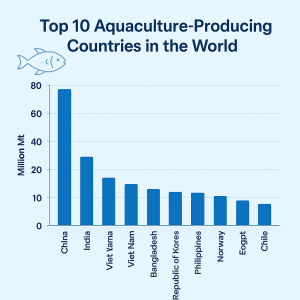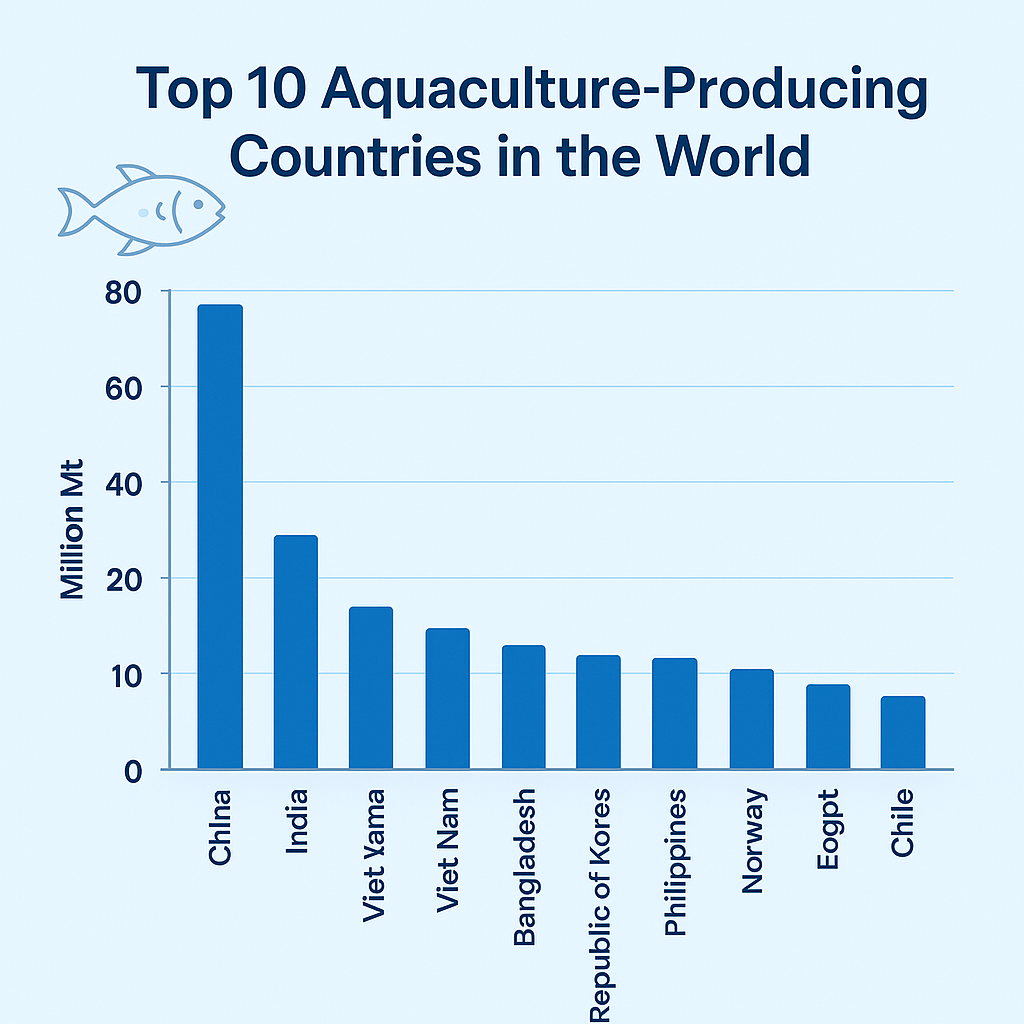Discover the top 10 aquaculture-producing countries shaping the future of fish farming in 2025. Explore trends, technologies, and global impacts in this comprehensive guide.
Why Aquaculture Leaders Matter in Global Food Security and Maritime Economies
Fish farming, also known as aquaculture, is no longer just an alternative to wild fisheries—it is a cornerstone of modern food systems and maritime economies. In 2025, aquaculture supplies more than 56% of the world’s seafood for human consumption, according to the FAO State of World Fisheries and Aquaculture (SOFIA, 2024). With wild fish stocks under pressure from overfishing and climate change, the role of aquaculture has become more vital than ever.
Top aquaculture-producing countries are not just feeding their populations but also exporting billions of dollars’ worth of farmed seafood to global markets. Their leadership drives innovation in hatchery science, sustainable feed alternatives, digital monitoring systems, and environmentally friendly farming practices. Whether it’s shrimp from India or tilapia from Egypt, the success of these countries in scaling aquaculture has global ripple effects—economically, environmentally, and socially.

A Closer Look at the Top 10 Aquaculture-Producing Nations in 2025
These countries represent the highest total output (volume and value) in aquaculture production and are driving the future of fish farming globally.
China
Estimated Production (2025): Over 65 million metric tons
Key Species: Carp, tilapia, shrimp, shellfish
China remains the undisputed leader in global aquaculture, accounting for more than 58% of the world’s farmed fish. With decades of government support, strong R&D institutions like the Chinese Academy of Fishery Sciences, and an integrated supply chain, China’s aquaculture dominance is unmatched.
The country is now shifting focus to quality over quantity, with initiatives in precision aquaculture, improved water treatment, and carbon footprint reduction. Inland provinces like Hubei and coastal zones like Guangdong lead the output, but challenges like water pollution and disease outbreaks are pushing regulatory reforms.
India
Estimated Production (2025): 9.2 million metric tons
Key Species: Shrimp, rohu, catla, pangasius
India is the world’s second-largest aquaculture producer, and the Andhra Pradesh region is its aquaculture heartland. India is also the leading exporter of farmed shrimp, largely to the U.S., EU, and Japan.
The National Fisheries Development Board and Marine Products Export Development Authority (MPEDA) have been instrumental in training farmers and promoting eco-certification practices. New policies under the Pradhan Mantri Matsya Sampada Yojana focus on digitization, disease surveillance, and improved cold-chain logistics.
Indonesia
Estimated Production (2025): 7.4 million metric tons
Key Species: Milkfish, tilapia, shrimp, catfish
Indonesia’s aquaculture sector spans everything from backyard ponds to high-tech coastal farms. The government’s Blue Economy Strategy emphasizes sustainable growth, supported by satellite monitoring and climate-resilient infrastructure.
The Ministry of Marine Affairs and Fisheries (MMAF) is expanding marine aquaculture in outer islands, while private players and NGOs are helping digitize smallholder operations. Disease remains a concern, especially for shrimp farms, but innovation in probiotic feeds and biofloc systems is offering solutions.
Vietnam
Estimated Production (2025): 6.9 million metric tons
Key Species: Pangasius, shrimp, tilapia
Vietnam’s Mekong Delta is one of the world’s most productive aquaculture zones. The country is renowned for pangasius farming and ranks among the top exporters of farmed seafood.
Vietnam is actively working to meet EU food safety standards, and its adoption of Best Aquaculture Practices (BAP) is expanding. Key infrastructure upgrades at ports like Can Tho and Ho Chi Minh City are enhancing cold-chain efficiency.
Bangladesh
Estimated Production (2025): 5.2 million metric tons
Key Species: Rohu, catla, pangasius, tilapia
Aquaculture plays a critical role in Bangladesh’s rural economy and nutrition. The Department of Fisheries (DoF) promotes hatchery development and low-cost, nutrient-rich species farming.
Floating cage systems in the Jamuna and Padma rivers are expanding, and climate-resilient aquaculture projects are supported by the World Bank and IFAD. However, flood events linked to climate change remain a persistent threat.
Egypt
Estimated Production (2025): 2.1 million metric tons
Key Species: Tilapia, mullet, catfish
As the largest aquaculture producer in Africa, Egypt depends heavily on the Nile Delta for freshwater aquaculture. Farms in the Kafr El Sheikh region lead in intensive tilapia production.
The General Authority for Fish Resources Development (GAFRD) is driving sustainability efforts, including saline water aquaculture and waste reuse. However, rising water salinity and limited feed resources pose ongoing challenges.
Chile
Estimated Production (2025): 1.6 million metric tons
Key Species: Atlantic salmon, trout, mussels
Chile is a global leader in cold-water aquaculture, especially in farmed salmon. After past setbacks from disease and algal blooms, Chile is investing in stricter environmental controls and genetic resilience.
With strong support from Sernapesca and partnerships with classification societies like DNV, Chilean farms are pioneering underwater robotics and remote sensors to improve fish health and reduce environmental impact.
Norway
Estimated Production (2025): 1.4 million metric tons
Key Species: Atlantic salmon, trout
Norway’s aquaculture story is a model of innovation. With cutting-edge offshore salmon farms and strong enforcement by the Norwegian Food Safety Authority and DNV, the country ensures biosecurity and traceability.
Smart cages, AI feeding systems, and underwater drones are transforming production in fjords and along the coast. Norway is also investing in closed containment systems and pursuing zero-emission vessels for aquaculture logistics.
Myanmar
Estimated Production (2025): 1.2 million metric tons
Key Species: Rohu, catla, pangasius, tilapia
Despite political instability, Myanmar remains a major player in freshwater aquaculture. It benefits from extensive pond systems and large rural labor pools.
International aid programs and research partnerships have helped train farmers in improved hatchery management and disease prevention. However, infrastructure bottlenecks limit export potential.
Philippines
Estimated Production (2025): 1.1 million metric tons
Key Species: Milkfish (bangus), tilapia, seaweeds
The Philippines’ coastal communities depend heavily on aquaculture for income and nutrition. The government’s Bureau of Fisheries and Aquatic Resources (BFAR) supports integrated fish-rice farming and mariculture parks.
Seaweed farming, a key livelihood for women in coastal provinces, is expanding due to international demand. Efforts are underway to improve post-harvest facilities and reduce losses from typhoons and salinity shifts.
–
Global Trends Driving Aquaculture Expansion
Digital Aquaculture Technologies
Sensors, AI, and machine learning are being used to monitor water quality, control feeding, and detect disease in real time. Companies like eFishery, Aquabyte, and Wärtsilä are developing cloud-based platforms that help both large-scale and smallholder farms.
Climate-Resilient Practices
From biofloc systems to recirculating aquaculture systems (RAS), farms are adopting methods that reduce water usage and increase yield. These systems are particularly useful in regions with limited freshwater or coastal degradation.
Sustainable Feeds and Circular Economy
Researchers are replacing fishmeal with insect protein, algae, and by-products. The Aquaculture Stewardship Council (ASC) and Marine Stewardship Council (MSC) are promoting certifications that reward sustainability.
Blue Economy Integration
Aquaculture is being integrated into broader maritime spatial planning. Offshore farms now coexist with wind turbines, shipping lanes, and conservation zones, especially in EU and Nordic countries.
Real-World Impacts: Communities and Oceans
Aquaculture has lifted millions out of poverty, especially in Asia and Africa. It supports over 20 million jobs globally, according to the World Bank (2024). But its growth also brings ecological pressures: nutrient pollution, habitat destruction, and antibiotic resistance.
Balancing yield and sustainability is the defining challenge. For example, India’s boom in shrimp exports created jobs but also raised alarms over mangrove loss. In Norway, massive salmon escapes led to debates over farm design and environmental ethics.
FAQs
Which country produces the most farmed fish in 2025?
China leads by a significant margin, producing over 60 million tons annually.
What species are most commonly farmed worldwide?
Tilapia, carp, shrimp, salmon, and catfish are among the top species.
Is aquaculture better than wild fishing?
Aquaculture reduces pressure on wild stocks but must be well-regulated to avoid environmental harm.
Can aquaculture help fight climate change?
Yes. Compared to livestock, fish farming has a lower carbon footprint and can be adapted to changing climates.
What are the risks of aquaculture?
Key risks include disease, water pollution, feed sustainability, and habitat damage.
Are there certifications for responsible aquaculture?
Yes. ASC, BAP, GlobalG.A.P., and MSC are key certification systems that promote sustainable practices.
Is offshore aquaculture the future?
It’s a growing trend, especially in countries like Norway, China, and the U.S., where space and water quality are limiting inshore expansion.
Here are the top 10 aquaculture-producing countries (by volume) as of 2021–2022, based on FAO data and other reliable sources:
-
China – ~72.8 Mt (≈56–58% of global production)
-
Indonesia – ~14.6 Mt (≈7%)
-
India – ~9.4 Mt (≈8%)
-
Viet Nam – ~4.75 Mt (≈5%)
-
Bangladesh – ~2.64 Mt
-
Republic of Korea – ~2.43 Mt
-
Philippines – ~2.27 Mt
-
Norway – ~1.66 Mt
-
Egypt – ~1.58 Mt
-
Chile – ~1.44 Mt
🌍 Key Insights
-
Top 10 dominance: These ten countries account for nearly 90% of global aquaculture output
-
Asia leads: Asia produces over 90% of farmed aquatic animals and plants
-
China’s share: China alone contributes roughly 56–58%, or even 70% in some estimates, of total output .
-
Historic milestone: In 2022, global aquaculture surpassed wild-capture fisheries—94.4 Mt farmed vs. 91 Mt captured
📊 Context & Trends
-
Rapid growth: From the 1990s to today, aquaculture has expanded nearly sevenfold, now contributing over 50% of seafood supply .
-
Species mix: Freshwater carp (e.g., grass carp) dominate inland production, while shrimp and salmon lead mariculture
-
Regional strengths:
-
China: Carp, tilapia, shrimp, seaweeds.
-
Indonesia, Vietnam, Bangladesh: Shrimp (especially whiteleg), carp, catfish.
-
Norway and Chile: Salmon farming.
-
Republic of Korea & Philippines: Seaweed and shellfish.
-
📈 Summary Table
| Rank | Country | Production Volume (Mt) |
|---|---|---|
| 1 | China | ~72.8 |
| 2 | Indonesia | ~14.6 |
| 3 | India | ~9.4 |
| 4 | Viet Nam | ~4.8 |
| 5 | Bangladesh | ~2.6 |
| 6 | South Korea | ~2.4 |
| 7 | Philippines | ~2.3 |
| 8 | Norway | ~1.7 |
| 9 | Egypt | ~1.6 |
| 10 | Chile | ~1.44 |
Let me know if you’d like a breakdown by species, region, or trends over time!
Conclusion
Aquaculture is no longer an emerging industry—it’s a pillar of maritime food systems and a major contributor to the global economy. From Asia to Latin America and Europe, leading aquaculture countries are pushing boundaries in production, technology, and sustainability.
Whether through AI-driven monitoring, climate-resilient design, or improved governance, the success of global aquaculture depends on balancing productivity with ecological integrity. With fish farming at the center of the blue economy, the world must now invest not only in volume but in vision.
References
- FAO. (2024). The State of World Fisheries and Aquaculture. https://www.fao.org/publications/sofia
- World Bank. (2024). Aquaculture and the Blue Economy. https://www.worldbank.org
- Marine Stewardship Council. https://www.msc.org
- Aquaculture Stewardship Council. https://www.asc-aqua.org
- DNV. https://www.dnv.com
- Wärtsilä Aquaculture Solutions. https://www.wartsila.com
- Sernapesca Chile. http://www.sernapesca.cl
- MPEDA India. https://mpeda.gov.in
- Chinese Academy of Fishery Sciences. http://www.cafs.ac.cn

